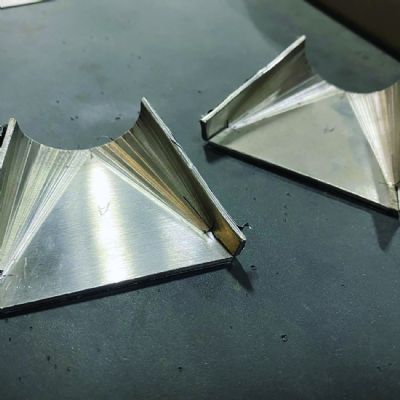Sensor Fundamentals, Part 1 Targets: Edges and Surfaces
June 1, 2010Comments
Starting with this column and continuing for the next five installments, I will address some of the most important fundamental topics crucial to the proper application of electronic sensors for metal forming and assembly. The applied science behind sensors is not hard, but it is critical to one’s success when it comes to die protection and the error-proofing of assembly operations. There is no magic or luck involved. Instead, a clear understanding of the basics followed by trial and error will lead to many successful sensor applications plant wide.
We begin with targets. It is paramount that a clear definition of the exact target be made in order to facilitate the appropriate “best guess” as to what sensor to try, followed by a bench test to verify the robustness of the choice. No matter how big or small the part, die component or assembly tooling, the target area is to be fully defined in both its metallurgical and dimensional aspects. Future installments will address the environmental conditions surrounding the target, but for our purposes here, we will limit our discussion to the target itself, independent of its immediate environment.
Edges—There are an infinite number of edge types within our industry. One could be faced with the challenge, for example, of the proper detection of a short feed. The edge of the strip that will be detected for this may be a nicely cut straight edge, a rough cut edge, a curved hole edge or steeply angular, say within a triangular hole. The edge of interest may be smooth or burred. It can be slightly tapered. The edge itself may have coined sections. Why think about all of this? Well, consider for example that inductive proximity sensor catalogs are based on edges being perfectly smooth, flat and traveling in a perfect perpendicular fashion sides into the inductive field. In later installments, we will look into the sensing-field shapes of the various sensor types. But in all cases, the edges are expected to be ideal.
Surfaces—The target surface entering a sensing field (be it inductive or photo-electric) is expected to be perfectly flat, solid and in a perfectly straight head-on trajectory as the target penetrates the sensor’s detection field. Your stamped part may have target surfaces that are round, gently tapered, steeply angled, punched with holes, dimpled, coined, slotted, etc. Again, the ideal expectation as shown in the sensor catalog will not be met in many surface-detection applications. The same holds true for tooling-component detection. The returning cam surface that you wish to monitor may be angled instead of being the ideal flat. The punch you wish to monitor for breakage may have some fairly intricate surfaces as would the detection of a tap surface, deeply threaded as it is, being detected during an in-die tapping application.
Area—The target entering the sensor’s detection field must have a minimum amount of area in order for the sensor to react. Again, the catalogs assume that this is a given but it may be far from so with your chosen target. Be the sensing field inductive or photoelectric, there must be a minimum amount of material that the field needs to react in order for the sensor to turn on or off. If this minimum is not present then the sensor may work erratically or not at all. This is true for edge or surface detection. You may have a deeply drawn part that is small in diameter and consequently presents a small surface area for detection. The same holds true for an edge. Your strip may be too thin for the edge to affect the inductive or photo-electric field and the sensor may be blind to its presence within its sensing field.
Metallurgy—A common item often overlooked is the metallurgy of the target. When using inductive proximity sensors, this can make or break the application as most such sensors are ideally presented in the catalogs using pure iron as the material being detected in the sensitivity charts and specifications. Iron gives the best performances by these sensors in terms of sensing-field ranges and sizes. Well, I have yet to see pure iron being stamped in our industry. From stainless to copper to aluminum, every type of material seems to find its into stampings except pure iron. With a few exceptions, inductive sensors will have a different range based on the metallurgy of the target. We will detail this challenge in a future installment of this column.
Why are the above factors so important? Consider the environmental realities of the stamping process (our next topic). The die and press are vibrating and shaking while the atmosphere within the die may be filled with an oil mist. If you do not have enough of an edge, surface, detection-field area or proper metallurgy for detection then you may be setting yourself up for the proverbial “nuisance stops.” You’ll irritate production personnel as the sensor, seemingly at random, stops the stamping or assembly process. The sensor you chose may have worked well on the test bench with the minimum target requirements, but placed within a die or assembly machine, where the environment causes the target to become unstable, the sensor may fail to make its detection.









